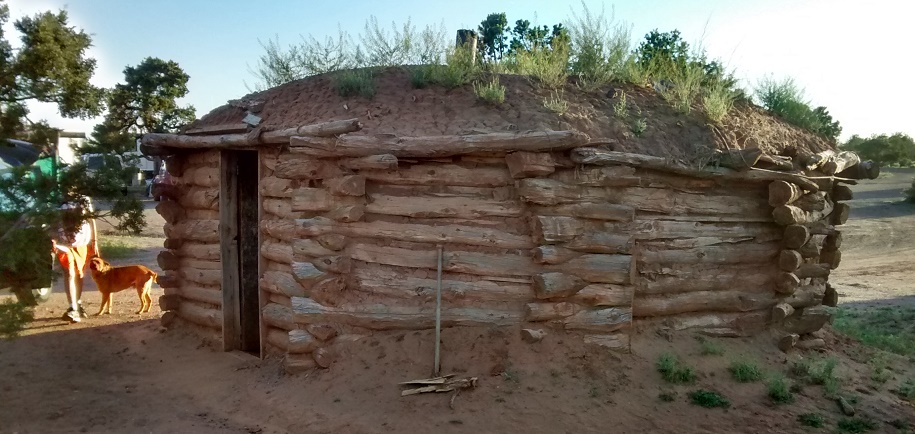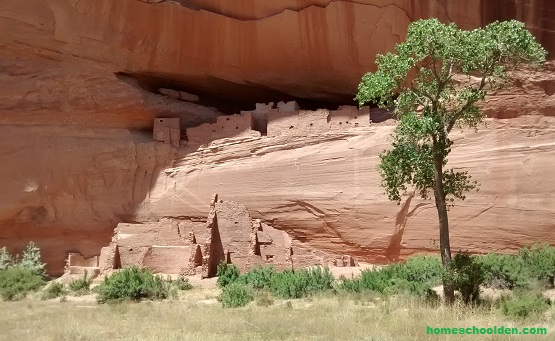Canyon de Chelly, (In the Navajo Nation)
We arrived at the Spider Rock Campground at Canyon de Chelly in the evening after a full day (about 10 hours!!) of driving… Howard, the owner of the campground was amazing and treated us like long-lost friends!! (I had emailed with him a number of times to make sure we had accommodations since the kids and I had to drive hundreds (and hundreds!!) of miles to get there.)
We had a tent, but opted to stay in a traditional Navajo Hogan. The kids absolutely loved that (and so did I)!! We soon got ourselves settled in and Howard brought us some firewood (which was great because a) we had s’mores (Yum!!) and b) it cooled off pretty quickly (since it was May).

ED and I were the first ones up. We decided to go for a walk out to the edge of the canyon. Canyon de Chelly is about 27 miles long. Our campground hosts’ dogs escorted us all the way out to the edge of the canyon (which ED loved, of course!!).



These pictographs were done by ancient Anasazi Indians who lived in the region.


According to some online sources, this is a 19th century pictograph which depicts Lt Antonio Narbona and his Spanish forces. Narbona took troop of soldiers to the area in January 1805 in response to a Navajo raid. The Navajo had made attacks on a Spanish military posts and nearby settlements because they were trying to recover grazing lands at the foot of Mt. Taylor (one of their sacred mountains).
The Spanish force battled the Navajos in 1805 and massacred 115 of them. They and took 33 women and children as slaves.
Fortress Rock & Kit Carson’s Campaign against the Navajo
At one point, Howard stopped and talked about Kit Carson’s campaign against the Navajo. As many of you know, the kids and I spent a couple of months studying some of the history about the Navajos (Cheyenne and Lakota Sioux) before we left on our trip. (See our free packet about Navajo history here.) But to see where this took place in person was amazing!
Kit Carson had a reputation for being sympathetic and accommodating to tribes such as the Mescaleros, Kiowas, and Navajo, but Carson waged a brutal campaign against the Navajo in 1863. Many Navajo were rounded up and soldiers destroyed homes and supplies, burned crops and peach orchards.
Two Navajo chiefs, Barboncito and Manuelito had both vowed not to surrender. The two led their followers to a rocky butte known as Fortress Rock, where the two canyons (Canyon de Chelly and Canyon del Muerto) join up.

Howard pointed to the end of the rock and said that the Navajo had long ladders which would allow them to descend into the canyon at night for water. They were able to hold out for quite some time. However, this isolated position left the Navajo without many necessities for the coming winter. Howard told us that at one point a young Navajo made noise (shot at the soldiers, I think he told us) and the Navajo were discovered and were forced to come down. Then they too were forced to make the Long Walk some three hundred miles from their home in Arizona to a reservation in eastern New Mexico. (There were more than 50 forced marches between August 1864 and the end of 1866.) Many Navajo died along the way.

At one point, we asked Howard if he knew anyone who a Navajo Code Talker (in World War II). He told us that his uncle was trained to be a Code Talker. He was to be a replacement if there were casualties, but he was never sent overseas.
After the tour, Howard dropped us off at the visitor center and then the kids and I drove along the rim and checked out the area we had just spent hours exploring!! The views from the top were beautiful… but seeing the 6,000 year old Anasazi cliff ruins and all of the ancient pictographs was unforgettable! Not to mention Howard and his insights and stories!! 

So, that’s it for today! See you again soon here or Homeschool Den Facebook page. Don’t forget to Subscribe to our Homeschool Den Newsletter! ~Liesl
You might be interested in our free notebook pages about the Navajo:


























































